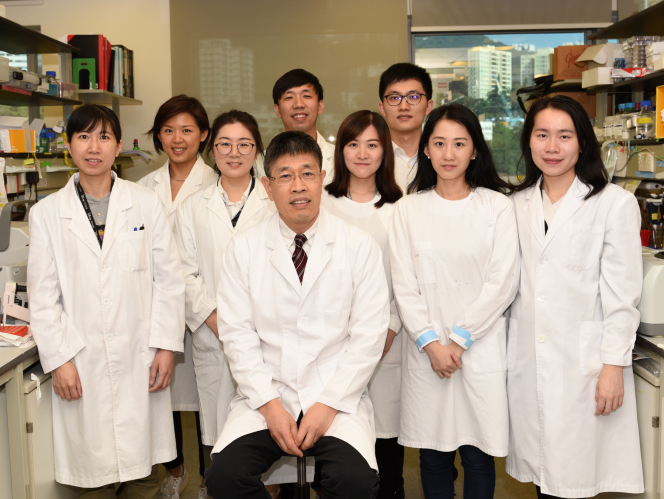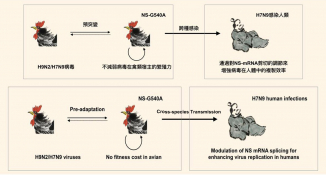Media
HKU Research Team Identifies Mutation in H7N9 Avian Influenza Virus
Increasing Human Infection Cases which Provides New Biomarker for Surveillance and Drug Target
22 Mar 2017
The outbreak of H7N9 avian influenza virus was first reported in mainland China in 2013. Human cases of H7N9 have surged in several Provinces since the autumn of 2016, causing over 500 cases of human infection in China up to March 2017. The research team from State Key Laboratory for Emerging Infectious Diseases of The University of Hong Kong (HKU) and Department of Microbiology, Li Ka Shing Faculty of Medicine, HKU identifies a mutation in H7N9 virus which causes the virus to possess a higher ability to infect humans while continue to circulate effectively in poultry. The finding can help monitor the emergence of mutations for cross-species transmission among avian influenza virus including H7N9 virus and provide new target for anti-virus drug development. The research has been published in the international journal Nature Communications on March 22.
Avian influenza virus
Human infection with avian influenza A H5N1 subtype virus was first reported in Hong Kong in 1997. H5N1 avian influenza has since caused over 800 cases of human infection all over the world and death in nearly half of these cases. The outbreak of H7N9 avian influenza virus was first detected in Eastern China in 2013 and numerous human infection cases have been reported each year since then. Till early 2017, multiple cities from 17 Provinces in China have confirmed more than 1,200 H7N9 human infection cases, causing over 400 deaths.
Despite the live poultry markets in major cities of China have been closed since the 2013 outbreak, 121 deaths among the more than 380 H7N9 human infection cases were recorded in the first three months of 2017. Although other avian influenza viruses, such as H5N1 and H9N2 viruses have also caused human infections, the medical sector considers the H7N9 outbreak unusual. Yet the reason why H7N9 virus can circulate effectively in avian host and cause human infection is still poorly understood.
Avian influenza A virus has to replicate in the cells of its host to establish effective infection. This mechanism does not only restrict infection and transmission of virus among various species, but also restrict the transmission of avian influenza A virus to mammals and humans. The seasonal influenza virus does not infect poultry and birds due to the mechanism.
Research findings
The latest study published by the research team from State Key Laboratory for Emerging Infectious Diseases and Department of Microbiology, Li Ka Shing Faculty of Medicine, HKU, reveals the reason why H7N9 avian influenza virus possesses distinct fitness in circulating in avian host and causing human infections. The team performs analysis of the H7N9 virus genome collected from 2013 onwards and reveals that efficient infection of both avian and human cells by H7N9 viruses is supported by a unique nucleotide substitution (NS-G540A) in NS segment, where the mutation is located within a previously undefined exonic splicing enhancer (ESE). The researchers show that the position of this nucleotide is part of an RNA sequence motif that binds the human host cellular mechanism which supports virus replication and it is a common function in all influenza viruses. Host splicing regulator, SF2, regulates the virus replication efficiency as it interacts with ESE. Mutation in ESE identified in the viral genome of H7N9 virus enhances the ability of virus replication in mammalian cells.
The team proves that this mutation in viral genome provides H7N9 virus with the ability to both circulate efficiently in avian hosts and replicate in mammalian cells. It is notable that human infections with H10N8 and H5N6 subtype avian influenza viruses contain the same mutation in the viral genome. This mutated nucleotide emerged in early 2000 in H9N2 strains and has since spread in avian influenza viruses, becoming the dominant genotype among avian influenza viruses from 2012 onwards. The H7N9 virus inherits the mutation from H9N2 virus. The 2013 H7N9 virus acquires internal genes from H9N2 virus and reassorts with haemagglutinin (HA) and neuraminidase (NA) genes from viruses present in wild birds, becoming the H7N9 virus that currently causes human infection.
Viruses that can infect humans are normally refrained from replication and transmission in avian cells. Yet the mutation in H7N9 virus can enhance the virus replication in mammalian and human cells, and causes no fitness cost for circulation of the virus in avian population. The mutation enables H7N9 virus to possess the cross-species transmission ability to infect humans. The primed condition of NS-G540A among H7N9 virus enhances replication ability in mammalian hosts and facilitates viral acquisition of other adaptive mutations during virus infection, which enables H7N9 virus to infect humans more effectively than other avian influenza viruses.
Significance of the study
“This study provides a plausible mechanism to explain the molecular properties which allows H7N9 virus to infect humans while retaining the ability to circulate in avian species. It provides an important biomarker for monitoring the emergence and transmission of avian influenza viruses in humans and preventing human-to-human infection of the viruses. The mutation can also serve as a novel target of anti-influenza drug development,” says Professor Chen Honglin, Professor of State Key Laboratory for Emerging Infectious Diseases and Department of Microbiology, Li Ka Shing Faculty of Medicine, HKU.
About the research team
Key investigators of the study include Professor Chen Honglin, Professor of State Key Laboratory for Emerging Infectious Diseases and Department of Microbiology, Professor Yuen Kwok-yung, Henry Fok Professor in Infectious Diseases, Chair Professor of Infectious Diseases from the Department of Microbiology, and Director of State Key Laboratory for Emerging Infectious Diseases, HKU, and Mr Huang Xiaofeng, Research Assistant of Department of Microbiology, Li Ka Shing Faculty of Medicine, HKU.
Please visit the website at http://www.med.hku.hk/news/ for press photos.
HKU identifies mutation in H7N9 virus which causes the virus to possess a higher ability to infect humans. Professor Chen Honglin, Professor of State Key Laboratory for Emerging Infectious Diseases and Department of Microbiology, Li Ka Shing Faculty of Medicine, HKU, points out that the finding can help monitor the emergence of mutations for cross-species transmission among avian influenza viruses and provide new target for anti-virus drug development.



